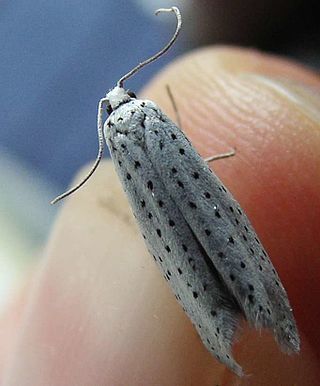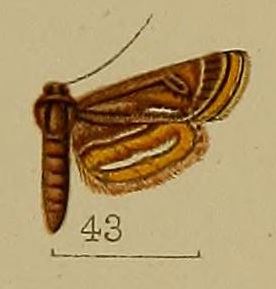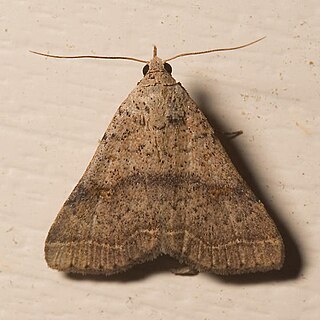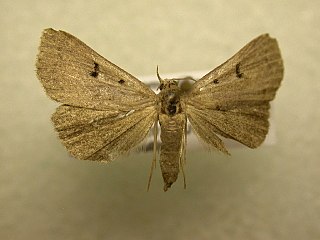
Lepidoptera or lepidopterans is an order of winged insects that includes butterflies and moths. About 180,000 species of the Lepidoptera have been described, representing 10% of the total described species of living organisms, making it the second largest insect order with 126 families and 46 superfamilies. and one of the most widespread and widely recognizable insect orders in the world.

The Pyralidae, commonly called pyralid moths, snout moths or grass moths, are a family of Lepidoptera in the ditrysian superfamily Pyraloidea. In many classifications, the grass moths (Crambidae) are included in the Pyralidae as a subfamily, making the combined group one of the largest families in the Lepidoptera. The latest review by Eugene G. Munroe and Maria Alma Solis retain the Crambidae as a full family of Pyraloidea.
Sir George Francis Hampson, 10th Baronet was an English entomologist.

Urodidae, whose species are commonly known as false burnet moths, is a family of moths in the lepidopteran order. It is the type genus in the superfamily, Urodoidea, with three genera, one of which, Wockia, occurs in Europe.

Heliodinidae, commonly known as sun moths, is a family of small moths with slender bodies and narrow wings. Members of this family are found in most parts of the world. Heliodinid moths are brightly coloured day-flying moths. The base of the haustellum is bare. The scales on the head are compact and appear like a shield. Many Heliodinidae raise their hindlegs when resting but this is not a taxonomic feature and several genera like Epicroesa and Lamprolophus do not show this posture. Many Heliodinidae have the inner and outer spurs of the metatibia subequal. The larval host plants of the majority of species are in the Aizoaceae, Chenopodiaceae, Phytolaccaceae, Portulacaceae and Nyctaginaceae, all in the Order Caryophyllales. A few feed on Onagraceae, Araliaceae and Piperaceae. The pupae have long stiff hairs on their back sides.
Agathiphaga is a genus of moths, known as kauri moths. It is the only living in the family Agathiphagidae. This caddisfly-like lineage of primitive moths was first reported by Lionel Jack Dumbleton in 1952, as a new genus of Micropterigidae.

The Herminiinae are a subfamily of moths in the family Erebidae. The members of the subfamily are called litter moths because the caterpillars of most members feed on dead leaves of plants, though others feed on living leaves, and/or the mushrooms of fungi as in the case of genus Idia.

Yponomeutinae is a subfamily of "micromoths" in the lepidopteran family Yponomeutidae. As their scientific name implies, this is the subfamily containing the type genus of the ermine moths, Yponomeuta. The subfamily has worldwide distribution.

The Thyatirinae, or false owlet moths, are a subfamily of the moth family Drepanidae with about 200 species described. Until recently, most classifications treated this group as a separate family called Thyatiridae.
Coniesta is a genus of moths of the family Crambidae.

Oligostigma is a genus of moths of the family Crambidae described by Achille Guenée in 1854.

Bleptina is a genus of litter moths of the family Erebidae. It was erected by Achille Guenée in 1854.

Diphtherinae is a monotypic subfamily of moths in the family Nolidae erected by Michael Fibiger and J. Donald Lafontaine in 2005. Its only genus, Diphthera, was erected by Jacob Hübner in 1809. The genus was moved from Noctuidae in 2013 after the phylogenetic analysis of Reza Zahiri et al. (2013).

Sterrhinae is a large subfamily of geometer moths with some 3,000 described species, with more than half belonging to the taxonomically difficult, very diverse genera, Idaea and Scopula. This subfamily was described by Edward Meyrick in 1892. They are the most diverse in the tropics with the number of species decreasing with increasing latitude and elevation.

Bleptina caradrinalis, the bent-winged owlet or variable snout moth, is a species of moth of the family Erebidae. It was described by Achille Guenée in 1852. It is found in North America, from Nova Scotia west to British Columbia, south to Arizona. Furthermore, it is found from southern North America south to Brazil and on the Antilles.
Bleptina sangamonia is a species of moth of the family Erebidae first described by William Barnes and James Halliday McDunnough in 1912. It is found in the US from Illinois and Maryland, south to at least South Carolina, but it is not present in Pennsylvania, New Jersey and Delaware.

Bleptina inferior, the inferior owlet moth, is a species of moth in the family Erebidae. It was described by Augustus Radcliffe Grote in 1872 and is found in North America, where it has been recorded from Iowa to Massachusetts, south to Texas and Florida.
Bleptina minimalis, the small owlet moth, is a species of litter moth in the family Erebidae. It was first described by William Barnes and James Halliday McDunnough in 1812 and it is found in North America.
Bleptina flaviguttalis is a species of litter moth in the family Erebidae first described by William Barnes and James Halliday McDunnough in 1912. It is found in North America.










